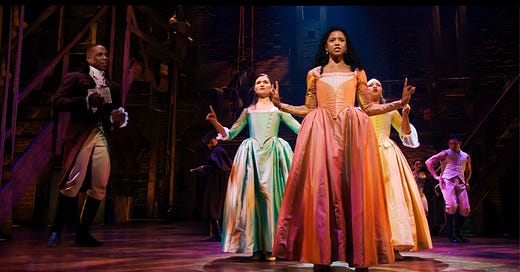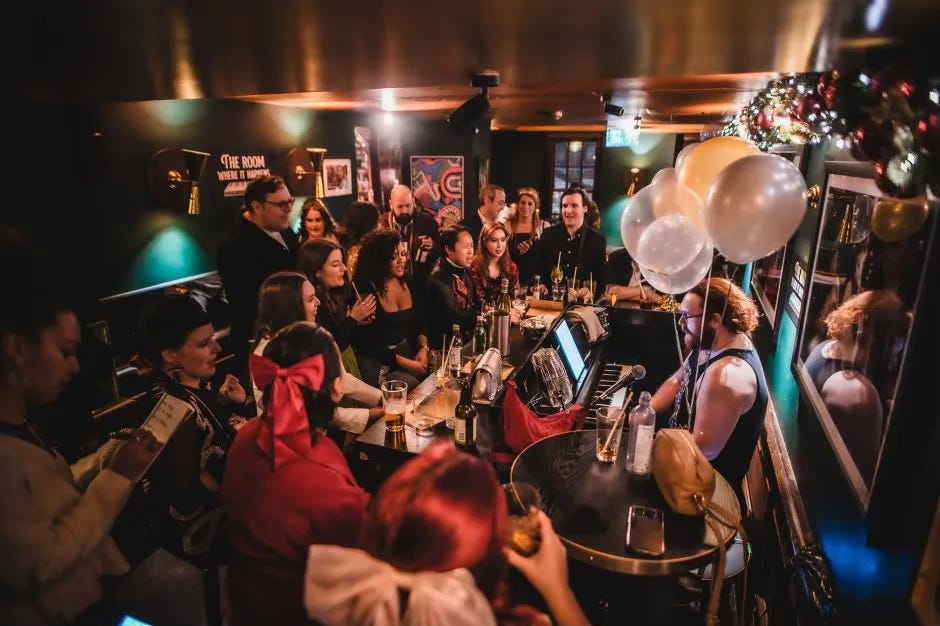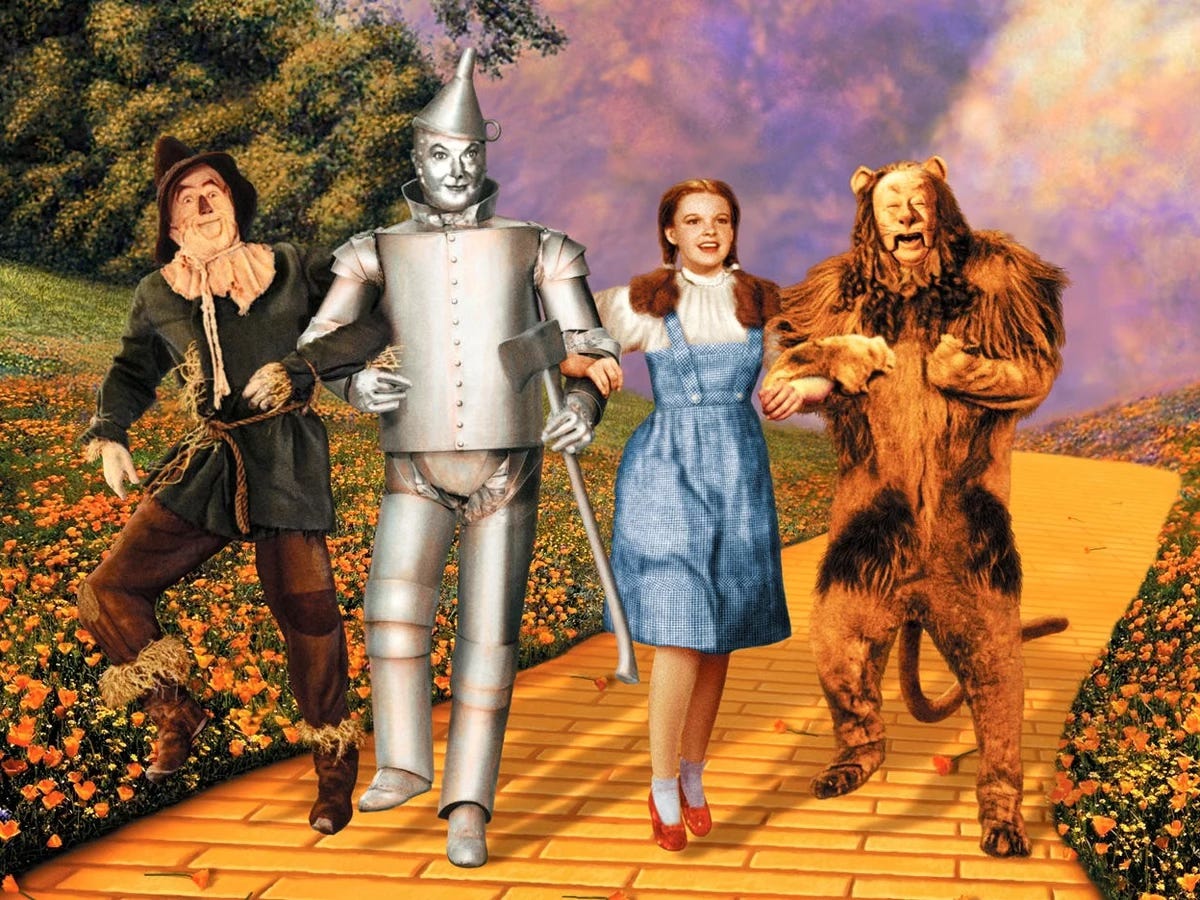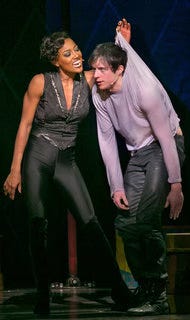We’re taking a close look at the STORY ELEMENTS that you find in all genres. These building blocks of drama are essential scenes in every novel, film, play —and really all kinds of non-fiction as well. Knowing what they are and where they generally appear in a story will get your book or script written — and fix your story problems faster — than anything else you can do.
I am always saying that the best training I ever got for writing novels, and screenplays, was my musical theater background (acting, directing, choreography).
There’s really no better way to see key Story Elements in action, because in a good musical, every Story Element is depicted in a song.
There’s a new club in Soho, THE ROOM WHERE IT HAPPENS (“London’s favourite musical theatre bar”) where the staff serves up show tunes along with your food, and there are late night singing sessions with wickedly accomplished pianists pounding out all the greatest musical theater hits for everyone to sing along. Very highly recommended, and it reminded me to do this post.
I know, I know — not all of you are musical theater nerds. But you don’t have to have a background in theater to learn volumes about writing a book from looking at musicals!
And there are a lot of parents here. And remember how I said last week that repeat viewing of your kids’ favorite movies can be hugely helpful to your craft? Well, think about it. How many kids’ movies are musicals? It’s Disney and Pixar’s bread and butter. Just saying - if you’re a parent here’s how you can take advantage of your hostage situation!
Also I would lay money that every single person reading this is extremely familiar with at least one musical: The Wizard of Oz. And for my money The Wizard of Oz is a teaching movie that every writer should have under their belt. It’s a pretty perfect template for the Hero/ine’s Journey structure, with some of the best-realized examples of key story elements you’re ever going to find on celluloid. It gives us all something to aspire to.
The Wizard of Oz breakdown
Looking at musical theater is an excellent way to learn how to dramatize Story Elements like Inner and Outer Desire, Inciting Incident/Call to Adventure:, Into the Special World, the Hero/ine’s Plan, the Antagonist’s Plan, Character Arc, Assembling the Team – virtually any important story element you can name. Musical theater knows to give those key elements the attention and import they deserve. What musicals do to achieve that is put those story elements into song and production numbers. They become SETPIECE SCENES to music.
And you know how I’m always encouraging you all to SPELL THINGS OUT? Well, there’s no better way to spell things out than in song. The audience is so entertained they don’t know you’re spoon-feeding them the plot.
You can’t put songs on the page. But you can absolutely learn from the energy and exuberance of songs and production numbers, and find your own ways of getting that same energy and exuberance onto the page in narrative versions of production design, theme, emotion and chemistry between characters, tone, mood, revelation – everything that good songs do.
EXAMPLES
Let’s look at some examples of essential Story Elements in song. I’ll start it off, and hopefully you’ll be thinking of some examples of your own.
DESIRE or WISH or WANT songs:
Your first act must give the reader or audience a clear idea of what your Hero/ine WANTS, their DESIRE, so that the reader/audience can want it for them (OR - hope that they don’t get it, if we can see from the start it’s the wrong thing to want!). There’s a DESIRE or WISH song in every musical, and in many musicals this is the opening number (except for the OVERTURE).
In Wizard, it’s “Somewhere Over the Rainbow.” There are far too many to list, but think of - “My Shot” (Hamilton). “Wouldn’t It Be Loverly?” (My Fair Lady), “Reflection” (from Mulan – also a great Inner/Outer Desire song).” “Corner of the Sky” (Pippin). “If I Were A Rich Man,” (Fiddler). “I’m The Greatest Star” from Funny Girl. “Good Morning Baltimore” from Hairspray. “Where is Love?” from Oliver!
When you have a character cluster such as Dorothy’s TEAM of the Scarecrow, Tin Man and Lion, they will almost always sing their own Desire song as a group number or with variations on the same song. The three oldest sisters in Fiddler on the Roof sing “Matchmaker.” The Schuyler Sisters sing “The Schuyler Sisters” in Hamilton.
The Scarecrow, Tin Man and Lion sing the three choruses of “If I Only Had a Brain/Heart/Nerve), which also serves as the Gathering the Team Sequence. The above are also examples of the RULE OF THREE.
It's also very effective to use a group number to express a GROUP DESIRE in an ensemble cast: as in “I Hope I Get It" in A Chorus Line. Every single one of those auditioning dancers wants the same thing: the job. The male soldiers of Mulan (one set of Mulan’s allies) express their own desires in “A Girl Worth Fighting For.”
I AM songs:
Sometimes instead of or along with a DESIRE song, the hero/ine has an I AM song, in which they express a belief or philosophy that will be challenged during the course of the musical. A great, hilarious example: “I Believe” from The Book of Mormon.
I AM songs also can be, and often are, WE ARE songs: ensemble numbers in which a town or a group sings together about a group philosophy. There are some great ones throughout musical theater: “When You’re a Jet” and “America” from West Side Story (which expresses battling philosophies both within the culture and the song), "This is Halloween" from The Nightmare Before Christmas, and “Tradition” from Fiddler on the Roof, also “Officer Krupke” from West Side Story, a groundbreaking number at the time, which is simultaneously a “We Are” song, a comic male specialty number, and a searing statement of the societal FORCES OF OPPOSITION in the story.
PLAN songs:
The hero/ine MUST say the PLAN out loud so that the reader or audience knows where the story is going! If you, the author, can’t state the Plan, then you don’t know what your story is.
And in a musical, the PLAN is always expressed in a song:
“Follow the Yellow Brick Road/We’re Off to See the Wizard” in The Wizard of Oz. “Surrey with the Fringe on Top” in Oklahoma! (hey, I’m always saying, dating is a Plan). “Don’t Rain On My Parade” from Funny Girl. "Tevye's Dream" — Fiddler on the Roof.
Interestingly, “Hakuna Matata” from The Lion King is a PLAN song: Simba’s Plan at the beginning of the story is just to have a good time (like Prince Hal in Henry V). Of course, we know that Plan is not going to save the kingdom from Scar! We want Simba to get his act together and do the responsible thing. I would also say “Luck Be A Lady” from Guys and Dolls is not just a Desire song but also a Plan song; often songs fulfill several story element functions.
Oh, and let’s not forget dark Plan songs! One of my favorites is the duet between antiheroes Sweeney Todd and Mrs. Lovett: “Have a Little Priest.” Their Plan is for Sweeney Todd to butcher people in his upstairs barber chair and send the bodies down for Mrs. Lovett to bake into her pies, thereby fulfilling both their Desires: Sweeney Todd’s for revenge on humanity (especially the Judge) and Mrs. Lovett’s to have a thriving pie shop and get closer to Sweeney Todd.
And then there’s the weirdest Plan song in the history of musical theater (if you ask me!): “Pore Jud is Daid” from Oklahoma! — in which the hero, Curly, tries to eliminate his rival for Laurie’s love by convincing him to hang himself so he can have a really great funeral. Seriously.
More on Oklahoma! - VIDEO
VILLAIN’S PLAN songs:
Scar’s song “Be Prepared” in The Lion King: is a production number that climaxes Act One. In the chilling Nazi-esque military parade of the hyenas, we see exactly what will happen to the animal kingdom if Simba doesn’t get his act together and defeat Scar. (Hmm, that’s all sounding so familiar… what does it remind me of?)
The Villain’s Plan song also expresses our FEAR of what will happen, and concurrent HOPE – that the Hero/ine will prevent this dire vision from happening.
I want to point out that very often in musicals and especially in film musicals and animation, the Villain does not have a song; they will express the plan in words and action, not music. Except in the rare case like Sweeney Todd, music tends to undercut the impact of the villainy – you wouldn’t want to see the Wicked Witch of the West burst into song, now, would you?
But when it’s done well, the Villain’s Plan song can be really scary and effective; as well as Scar’s song from The Lion King, “Hellfire” from The Hunchback of Notre Dame is surprisingly graphic and true.
However, as we see in The Nightmare Before Christmas, having a villain sing can make them less threatening to children, which is an important consideration. In Nightmare we get a classic VILLAIN’S PLAN song: main villain Oogie Boogie sings about how he’s going to torture Santa Claus in a down and dirty New Orleans-style number, which musical theater loves, especially as a musical style for the villain. It undercuts the villainy by making it seem sexy and appealing and danceable, which in a children’s film takes the edge off the scariness of this monster.
Also, secondary villains are often given the songs (rather than the main villain) so you can have a vicarious musical delight in the evil before the real evil kicks in. Herod’s flashy honky-tonk song in Jesus Christ Superstar is a good example, as is King George’s infectious “You’ll Be Back” in Hamilton.
TRAINING SEQUENCE songs:
“You’ve Got to Pick a Pocket or Two” from Oliver! is a rousing example of a training song, as dark mentor Fagin charmingly teaches the boys to steal for him. “The Rain in Spain” from My Fair Lady is a training sequence song that turns into a Breakthrough or Triumph song. “Moses Supposes” from Singin’ in the Rain turns the tables on the very ineffective trainer. “I’ll Make a Man Out Of You” from Mulan. There’s some great irony, there, as the song also expresses the hero’s philosophical flaw as well as the theme of the movie.
MENTOR songs:
The Mentor character often sings the Training Sequence song. “True to Your Heart” from Mulan, “Hakuna Matata” from The Lion King, Aunt Eller’s “The Farmer and the Cowman Should Be Friends” in Oklahoma! “Bear Necessities" from Jungle Book is both an I Am song and a Mentor song. “On the Right Track” from Pippin (which also could be read as a Temptation Song).
Most of the songs in the first half of Godspell are Training/Mentor songs, as befitting one of the ultimate Mentor stories.
The TRIUMPH or BREAKTHROUGH song:
“The Rain in Spain Stays Mainly In The Plain.” “Ding Dong the Witch is Dead.” “Good Morning” (from Singin’ in the Rain). This number is often at an Act Climax or Midpoint.
The Triumph can be and often is the realization or reciprocation of love: “I Could Have Danced All Night,” “If I Were A Bell” (from Guys and Dolls), "Now I Have Everything" from Fiddler, “Singin’ in the Rain” from… yeah, you got it.
ALLIES’ songs and SIDEKICK songs:
Some of the best numbers in musicals are Allies’ Songs and Sidekick Songs. Allies’ Songs very often, if not almost always, express the Ally’s Desire (“If I Only Had a Brain”) and are often a comic counterpoint to the hero or heroine and/or the hero/heroine love relationship (Ado Annie and Will in Oklahoma! and Bernardo and Anita in West Side Story are two great examples). These songs are also often character dances such as tap, hip-hop, regional dances, modern, swing, salsa, samba, or tango.
I have to add that my absolute favorite kind of musical theater song is the SPECIALTY DANCE NUMBER: a group of usually five to seven women, the heroine’s coworkers or allies, in a song and dance showstopper like the ones Bob Fosse is so famous for — “Steam Heat,” “Big Spender,” “Mein Herr,” “Jailhouse Tango.” Of course you also find showstoppers featuring a small group of men, the classic tap numbers you see time and again both on stage and in film, and larger ensemble dances such as the breathtaking gang dance numbers of West Side Story, but I wanted to bring the female equivalent up as an example of subversive female empowerment.
NEW WAY OF LIFE songs:
Musical finales are a great way to see the emotional impact of the New Way of Life scene, and hopefully steal some of that exhilaration for ourselves.
“Let’s Go Fly a Kite” from Mary Poppins is both a CHARACTER ARC song and a NEW WAY OF LIFE song, as the stodgy banker father quits his job to take his neglected children to the park to fly a kite. The final, titular song from Oklahoma! celebrates the union of the farmers and ranchers in the brand new state of Oklahoma. In Godspell the ensemble reprise of “Prepare Ye the Way of the Lord” lifts the audience’s spirits to the heights after the devastation of the Crucifixion.
Whether or not you’re using music, song, and dance in a story, you can learn volumes about creating emotionally effective scenes from looking at how musical theater handles key story elements. Take a favorite musical and watch it with that idea in mind. I think you’ll be amazed.
And by the way, I've made up a lot of those names for songs and dance numbers! As always, feel free to do the same.
Related posts:
The Wizard of Oz - story breakdown (Also Chapter 50 in Stealing Hollywood & Writing Love)
Nightmare Before Christmas - song by song breakdown - Stealing Hollywood Chapter 26
Encanto - story breakdown
Why subscribe?
Screenwriting Tricks for Authors is a reader-supported publication. Please consider contributing to this work by becoming a free or paid subscriber!
Get the workbooks!
Stealing Hollywood ebook, $4.99, also available as large format print workbook
Writing Love ebook, $2.99
Need some help? The Screenwriting Tricks for Authors workshop is available online, as a self-paced course with all the videos, assignments, movie breakdowns and personalized feedback you need to get that book written this year, 15 minutes at time.
In three parts, and you only pay for what you use.
If you have a first draft of a book or script already, or need more feedback, get targeted help getting you over the finish line in The Writers’ Room.









